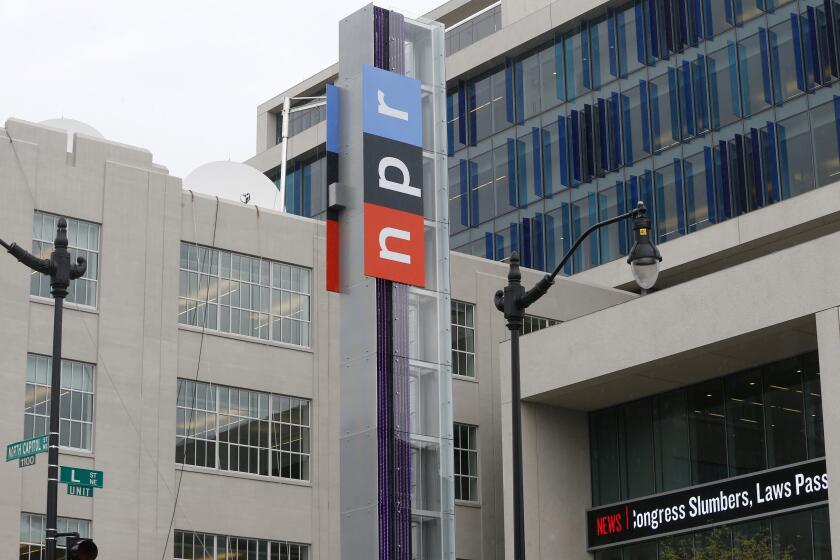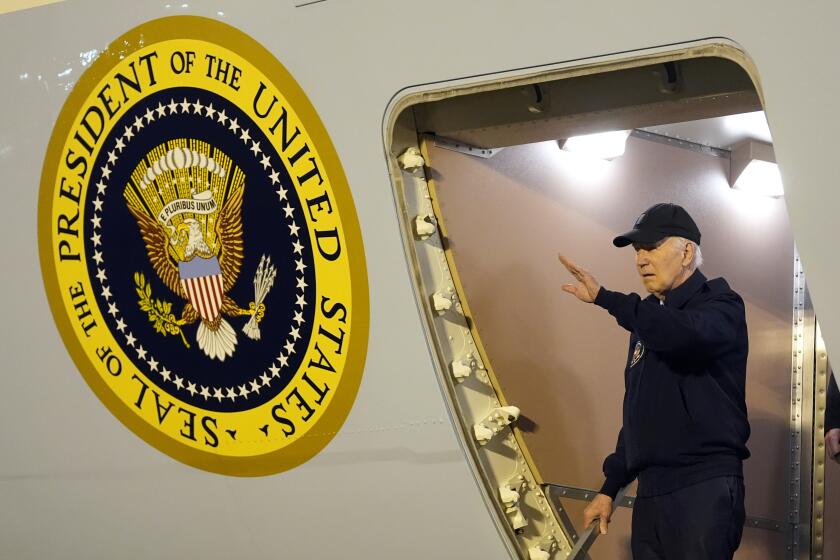Hollywood isn’t ready for AI. These people are diving in anyway

- Share via
When filmmakers say they’re experimenting with artificial intelligence, that news is typically received online as if they had just declared their allegiance to Skynet.
And so it was when Darren Aronofsky — director of button-pushing movies including “The Whale” and “Black Swan” — last week announced a partnership with Google AI arm DeepMind to use the tech giant’s capabilities in storytelling.
Aronofsky’s AI-focused studio Primordial Soup is producing three short movies from emerging filmmakers using Google tools, including the text-to-video model Veo. The first film, “Ancestra,” directed by Eliza McNitt, will premiere at the Tribeca Festival on June 13, the Mountain View-based search giant said.
Google’s promotional materials take pains to show that “Ancestra” is a live-action film made by humans and with real actors, though it’s bolstered with effects and imagery — including a tiny baby holding a mother’s finger — that were created with AI.
The partnership was touted during Google’s I/O developer event, where the company showed off the new Veo 3, which allows users to create videos that include sound effects, ambient noise and speech (a step up from OpenAI-owned competitor, Sora). The company also introduced its new Flow film creation tool, essentially editing software using Google AI functions.
Google’s push to court creative types coincides with a separate initiative to help AI technology overcome its massive public relations problem.
As my colleague Wendy Lee wrote recently, the company is working with filmmakers including Sean Douglas and his famous father Michael Keaton to create shorts that aren’t made with AI, but instead portray the technology in a less apocalyptic light than Hollywood is used to.
Simply put, much of the public sees AI as a foe that will steal jobs, rip off your intellectual property, ruin your childhood, destroy the environment and possibly kill us all, like in “The Terminator,” “2001: A Space Odyssey” and the most recent “Mission: Impossible” movies. And Google, which is making a big bet by investing in AI, has a lot riding on changing that perception.
There’s a ways to go, including in the entertainment industry.
Despite the allure of cost-savings, traditional studios haven’t exactly dived headfirst into the AI revolution. They’re worried about the legal implications of using models trained on troves of copyrighted material, and they don’t want to anger the entertainment worker unions, which went on strike partly over AI fears just a couple years ago. The New York Times and others have sued OpenAI and its investor Microsoft, alleging copyright theft. Tech giants claim they are protected by “fair use.”
AI-curious studios are walking into a wild, uncharted legal landscape because of the amount of copyrighted material being mined to teach the models, said Dan Neely, co-founder of startup Vermillio, which helps companies and individuals protect their intellectual property.
“The major studios and most people are going to be challenged using this product when it comes to the output content that you can and cannot use or own,” Neely said by phone. “Given that it contains vast quantities of copyrighted material, and you can get it to replicate that stuff pretty easily, that creates chaos for someone who’s creating with it.”
But while the legacy entertainment business remains largely skeptical of AI, many newer, digitally-native studios and creators are embracing it, whether their goals are to become the next Pixar or the next Mr. Beast.
The New York Times recently profiled the animation startup Toonstar, which says it uses AI throughout its production process, including when sharpening storylines and lip-syncing. John Attanasio, a Toonstar founder, told the paper that leaning into the tech would make animation “80 percent faster and 90 percent cheaper than industry norms.”
Jeffrey Katzenberg, the former leader of DreamWorks Animation, has given a similar estimate of the potential cost-savings for Hollywood cartoons.
Anyone working in the traditional computer animation business would have to gulp at those projections, whether they turn out to be accurate or not. U.S. animation jobs have already been hammered by outsourcing. Now here comes automation to finish the job. (Disney’s animated features cost well over $100 million to produce because they’re made by real-life animators in America.)
Proponents of AI will sometimes argue that the new technology isn’t a replacement for human workers, but rather a tool to enhance creativity. Some are more blunt: Stop worrying about these jobs and embrace the future of uninhibited creation. For obvious reasons, workers are reluctant to buy into that line of thinking.
More broadly, it’s still unclear whether all the spending on the AI arms race will ultimately be worth the cost. Goldman Sachs, in a 2024 report, estimated that companies would invest $1 trillion in AI infrastructure — including data centers, chips and the power grid — in the coming years.
But that same report raised questions about AI’s ultimate utility.
To be worth the gargantuan investment, the technology would have to be capable of solving far more complex problems than it does now, said one Goldman analyst in the report. In recent weeks, the flaws in the technology have crossed over into absurd territory: For example, by generating a summer reading list of fake books and legal documents polluted with serious errors and fabrications.
Big spending and experimentation doesn’t always pan out. Look at virtual reality, the metaverse and the blockchain.
But some entertainment companies are experimenting with the tools and finding applications. Meta has partnered with horror studio Blumhouse and James Cameron’s venture Lightstorm Vision on AI-related initiatives. AI firm Runway is working with Lionsgate. At a time when the movie industry is troubled in part due to the high cost of special effects, production companies are motivated to stay on top of advancing tech.
One of the most common arguments in favor of giving in to AI is that the technology will unshackle the next generation of creative minds.
Some AI-enhanced content is promising. But so far AI video tools have produced a remarkable amount of content that looks the same, with its oddly dreamlike sheen of unreality. That’s partly because the models are trained on color-corrected imagery available on the open internet or on YouTube. Licensing from the studios could help with that problem.
The idea of democratizing filmmaking through AI may sound good in theory. However, there are countless examples in movie history — including “Star Wars” and “Jaws” — of how having physical and budgetary restrictions are actually good for art, however painful and frustrating they may have been during production.
Even within the universe of AI-assisted material, the quality will vary dramatically depending on the talent and skill of people using it.
“Ultimately, it’s really hard to tell good stories,” Neely said. “The creativity that defines what you prompt the machine to do is still human genius — the best will rise to the top.”
Like other innovations, the technology will improve with time, as the new Google tools show. Both Veo 3 and Flow showcase how AI is becoming better and easier to use, though they are still not quite mass-market products. For its highest tier, Google is charging $250 a month for its suite of tools.
Maybe the next Spielberg will find their way through AI-assisted video, published for free on YouTube. Perhaps Sora and Veo will have a moment that propels them to mainstream acceptance in filmmaking, as “The Jazz Singer” did for talkies.
But those milestones still feel a long way off.
You’re reading the Wide Shot
Ryan Faughnder delivers the latest news, analysis and insights on everything from streaming wars to production — and what it all means for the future.
You may occasionally receive promotional content from the Los Angeles Times.
Stuff we wrote
Number of the week

The Memorial Day weekend box office achieved record revenue (not adjusting for inflation) of $329.8 million in the U.S. and Canada, thanks to the popularity of Walt Disney Co.’s “Lilo & Stitch” and Paramount’s “Mission: Impossible — The Final Reckoning.”
Disney’s live-action remake generated $183 million in domestic ticket sales, exceeding pre-release analyst expectations, while the latest Tom Cruise superspy spectacle opened with $77 million. The weekend was a continuation of a strong spring rebound for theaters. Revenue so far this year is now up 22% versus 2024, according to Comscore.
This doesn’t mean the movie business is saved, but it does show that having a mix of different kinds of movies for multiple audiences is healthy for cinemas. Upcoming releases include “Karate Kid: Legends,” “Ballerina,” “How to Train Your Dragon” and a Pixar original, “Elio.”
“Lilo & Stitch” is particularly notable, coming after Disney’s previous live-action redo, “Snow White,” bombed in theaters. While Snow White has an important place in Disney history, Stitch — the chaotic blue alien — has quietly become a hugely important character for the company, driving enormous merchandise sales over the years.
The 2002 original wasn’t a huge blockbuster, coming during an awkward era for Walt Disney Animation, but the remake certainly is.
Finally ...
Watch: Prepping for the new “Naked Gun” by rewatching the classic and reliving the perfect Twitter meme.
Listen: My favorite episode of “Blank Check with Griffin & David” in a long time — covering Steven Spielberg’s “Hook” with Lin-Manuel Miranda.
Inside the business of entertainment
The Wide Shot brings you news, analysis and insights on everything from streaming wars to production — and what it all means for the future.
You may occasionally receive promotional content from the Los Angeles Times.











